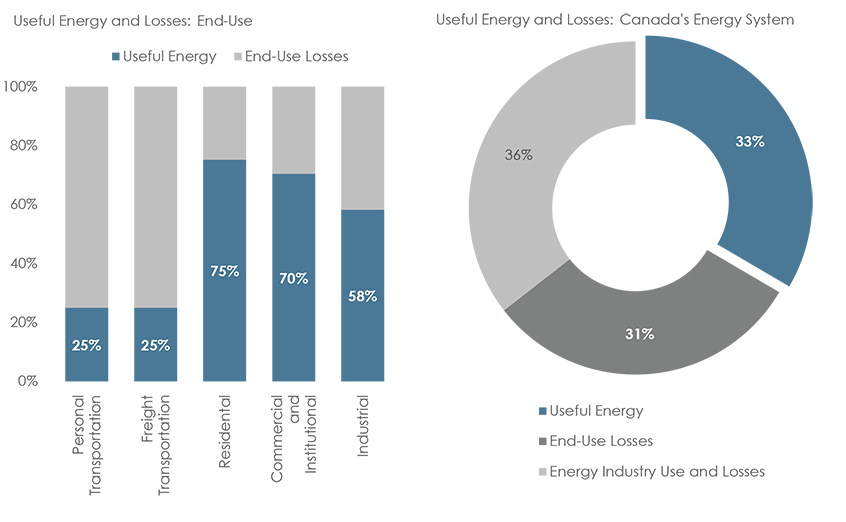Canada’s Energy Transition: Historical and Future Changes to Energy Systems – Update – An Energy Market Assessment

2. Energy Systems
Energy is closely tied to our quality of life as Canadians. Energy keeps us warm in the winter, cool in the summer, and provides us with light 24 hours a day. Energy enables the movement of people, goods, and services across the country and around the globe. It enables nearly all aspects of modern life from refrigerating foods and cooking meals to keeping us alive in extreme environments.
Energy also contributes to our national standard of living; accounting for 10% of our gross domestic product (GDP) and directly employing over 276 000 Canadians.Footnote 5 The other 90% of Canada’s GDP is highly reliant on energy for the provision of goods and services.Footnote 6
The interaction of the production, conversion, storage, distribution, and end-use of energy is what’s called an energy system. Table 1 illustrates the energy systems in Canada – from primary energy sources to the end-use where energy is converted to heat, work, or materials. In this sense, energy is a derived demand. That is, demand for energy comes entirely from our demand for the necessities for life.
Table 1: Energy Systems in Canada
| Primary Energy | Production | Conversion | Distribution | End-Use |
|---|---|---|---|---|
| Renewables | Naturally occurring | Photovoltaic cells, wind turbines, steam turbines, and hydro turbines convert solar, wind, underground heat, and water to electricity. | Electricity grid | Electricity generation and consumption |
| Natural gas | Drilling and extraction | No conversion, but natural gas processing removes impurities and natural gas liquids. Liquefied natural gas facilities cool natural gas to a liquid for transport. | Pipeline networks, ship (as liquefied natural gas), truck (as liquefied or compressed natural gas) | Space heating, electricity generation and consumption, transportation, non-energy uses |
| Crude oil | Drilling and extraction | Upgraders convert bitumen into synthetic crude oil. Refineries convert oil into petroleum products, such as gasoline, diesel, heating oil, bunker fuel (for ships). | Pipeline, ship, rail, truck | Transportation, space heating, electricity generation and consumption, non-energy uses |
| Coal | Mining | No conversion, but coal processing facilities wash and sort coal prior to use in power plants. | Ship, rail | Electricity generation and consumption, some space heating |
| Uranium | Mining | Uranium processing refines, enriches and converts uranium ore to fuel pellets and bundles for use in reactors. | Ship, rail, truck | Electricity generation and consumption |
Source: NEB
When energy is used for heat or put to work (gasoline to power a car forward, for example), it is said to be useful. However, as energy is transformed from its primary energy source, transported to the end-user, or consumed by the end-user, losses and inefficiencies occur.
Figure 1 illustrates that the vast majority of energy consumed in Canada is ultimately lost. Energy losses can occur at all points in an energy system; that is, within the processes of production, conversion, and distribution of energy, or with the end-user.
Figure 1: Useful Energy and Losses in Canada, 2013

Source: Canadian Energy Systems Analysis Research
Description:
These two graphs illustrate useful energy and losses of energy in Canada. The stacked bar chart illustrates that, for example, only 25% of the energy consumed by the personal transportation and freight transportation sectors is useful. The remaining 75% is wasted. In the residential, commercial and institutional, and industrial sectors, 75%, 70%, and 58% of the energy consumed is useful, while the remainder is wasted.
For Canada’s energy demand as a whole, only 33% of the energy consumed or transformed is useful as 31% is lost in the end-use sector, and 36% is lost through conversion and transformation by the energy industry.
Within the energy industry, energy is lost through the use of energy, or through the energy conversion process. Examples of energy that is lost in the conversion process is evident through the fuels and electricity consumed by the petroleum industry along the supply chain, and the losses associated with the generation, transmission and distribution of electricity to end-users.Footnote 7
End-use losses are the differences between the fuel and electricity consumed by the end user and an estimate of the ultimate useful energy that is delivered. For personal and freight transportation, only 25% (on average) of the fuel consumed by vehicles and vessels is ultimately used for movement. The remaining 75% is lost from friction, combustion, exhaust heat, and idling.
Understanding how energy is produced, transformed, and consumed, as well as how to make these processes more efficient is a fundamental element of the energy transition. Other key elements include understanding how much energy we consume, what types of energy we consume, and the environmental effects of our energy needs.
- Date modified:
